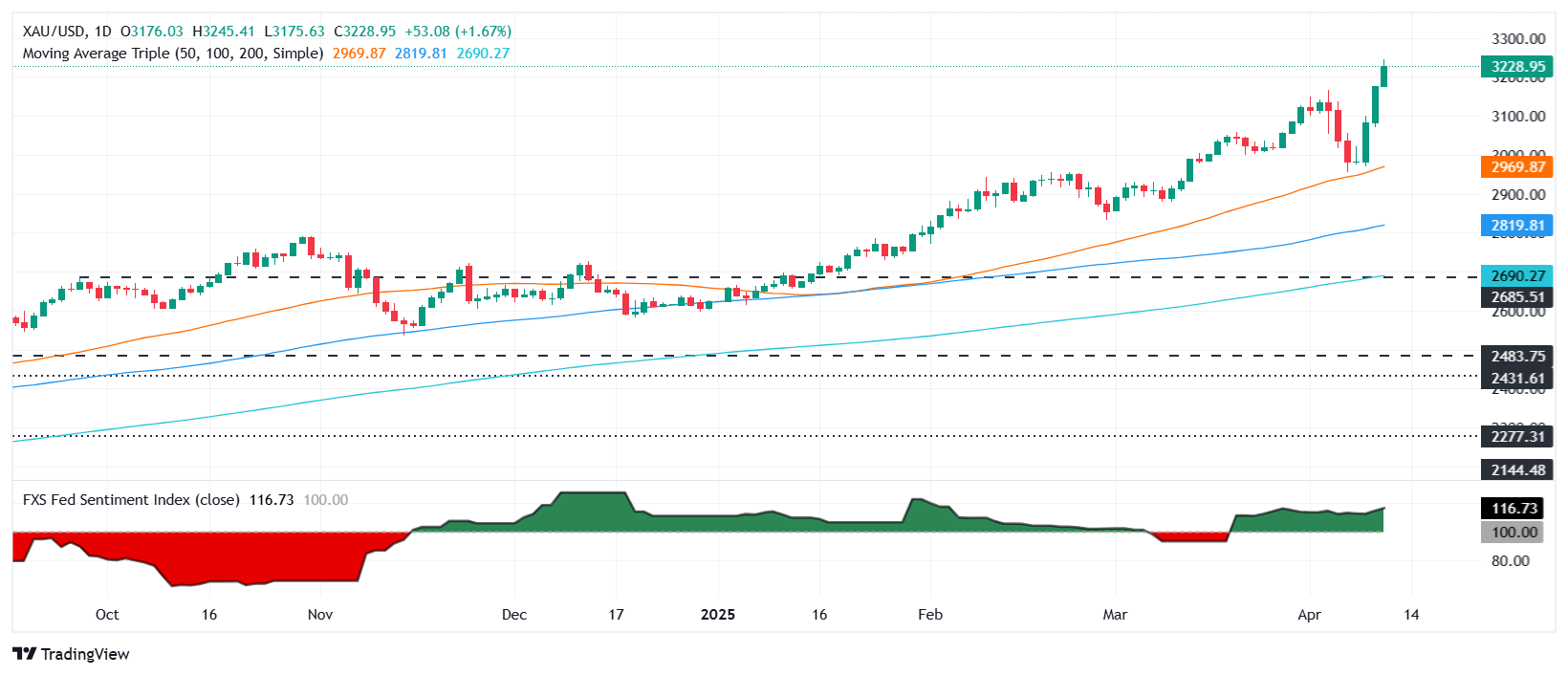- XAU/USD shoots more than 2% as investors seek refuge in the middle of the tariff battle between the US and China and inflationary uncertainty.
- China responds with a 125% tariff after the US raises taxes to 145%, which triggers a global career towards safe refuge assets.
- The US dollar index collapses to 99.01, its lowest level since May 2022, amplifying the rupture of gold to new historical maximums.
The gold price rally extended for the third consecutive day on Friday, with the yellow metal reaching a new historical maximum of $ 3,245. Profits of more than 2% were recorded in the middle of the escalation of the commercial war between the US and China and its impact on the global economy. At the time of writing, the XAU/USD quotes at $ 3,233.
During the American session, China applied 125% tariffs to the US as retaliation for the decision of US President Donald Trump to increase his taxes to 145% on Chinese products. Therefore, investors seeking security promoted gold prices, benefited by a weaker dollar, which collapsed to a minimum close to three years, as shown by the US dollar index (DXY) reaching 99.01.
The economic agenda presented some Federal Reserve officials (FED) crossing the news. Inflation on the producer’s side dropped both in general and underlying readings, although the latter remain on the 3%threshold. After that, the consumer’s feeling survey at the University of Michigan revealed that US households became pessimistic about the economic situation and worried about inflation expectations.
Although the data were mixed, this could prevent the Fed from loosening the policy due to commercial tariffs, which are considered prone to inflation. Therefore, since the Fed is probably staying in waiting mode, operators are now completely valuing three interest rate cuts in 2025.
What moves the market today: the price of gold shoots, without being affected by the high US high yields.
- The 10 -year Treasury bond performance of the US rises seven basic points to 4,495%. The real US yet yields fired seven and a half points to 2,307%, as shown in the yields of the US Treasury values protected against 10 -year inflation that failed to limit gold prices.
- The consumer’s feeling index of the University of Michigan showed a remarkable fall in April, falling from 57.0 to 50.8, pointing out an increase in pessimism among homes. Inflation expectations were shot, with a year perspective by jumping from 5% to 6.7% and the five -year forecast increasing from 4.1% to 4.4%.
- The US Production Price Index (IPP) for March fell to 2.7% year -on -year, lowering 3.2% and below the 3.3% forecast, suggesting a decrease in input cost pressures. However, the underlying IPP – which excludes food and energy – remained above the 3% threshold, standing at 3.3% year -on -year, lowering 3.5% in February and slightly below the 3.6% estimate.
- On Friday, some US banks expressed that the probability of a recession had increased. Among them are Wells Fargo and Morgan Stanley CEO, Ted Pick.
- JPMorgan’s CEO Jamie Dimon said that the chances of recession in the US are 50%.
- The fears of recession have increased, according to Goldman Sachs, which said that the possibilities of a recession increased from 35% to 45% in 12 months.
Technical perspective of the Xau/USD: The price of gold exceeds the levels of $ 3,100 and $ 3,200 when reaching a historical maximum
The upward trend of gold price remains intact with buyers pointing to the level of $ 3,250. A rupture of the current historical maximum (ATH) of $ 3,245 could pave the way to the latter. If those two levels of ceiling are exceeded, the next stop would be $ 3,300.
On the contrary, if the Xau/USD falls below $ 3,200, the first support would be the maximum of April 10, $ 3,176. Once exceeded, the next stop would be the level of $ 3,100.

FAQS GOLD
Gold has played a fundamental role in the history of mankind, since it has been widely used as a deposit of value and a half of exchange. At present, apart from its brightness and use for jewelry, precious metal is considered an active refuge, which means that it is considered a good investment in turbulent times. Gold is also considered a coverage against inflation and depreciation of currencies, since it does not depend on any specific issuer or government.
Central banks are the greatest gold holders. In their objective of supporting their currencies in turbulent times, central banks tend to diversify their reserves and buy gold to improve the perception of strength of the economy and currency. High gold reserves can be a source of trust for the solvency of a country. Central banks added 1,136 tons of gold worth 70,000 million to their reservations in 2022, according to data from the World Gold Council. It is the largest annual purchase since there are records. The central banks of emerging economies such as China, India and Türkiye are rapidly increasing their gold reserves.
Gold has a reverse correlation with the US dollar and US Treasury bonds, which are the main reserve and shelter assets. When the dollar depreciates, the price of gold tends to rise, which allows investors and central banks to diversify their assets in turbulent times. Gold is also inversely correlated with risk assets. A rebound in the stock market tends to weaken the price of gold, while mass sales in higher risk markets tend to favor precious metal.
The price of gold can move due to a wide range of factors. Geopolitical instability or fear of a deep recession can cause the price of gold to rise rapidly due to its condition of active refuge. As an asset without yield, the price of gold tends to rise when interest rates lower, while the money increases to the yellow metal. Even so, most movements depend on how the US dollar (USD) behaves, since the asset is quoted in dollars (Xau/USD). A strong dollar tends to keep the price of gold controlled, while a weakest dollar probably thrusts gold prices.
Source: Fx Street
I am Joshua Winder, a senior-level journalist and editor at World Stock Market. I specialize in covering news related to the stock market and economic trends. With more than 8 years of experience in this field, I have become an expert in financial reporting.







